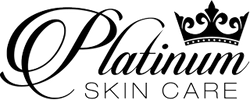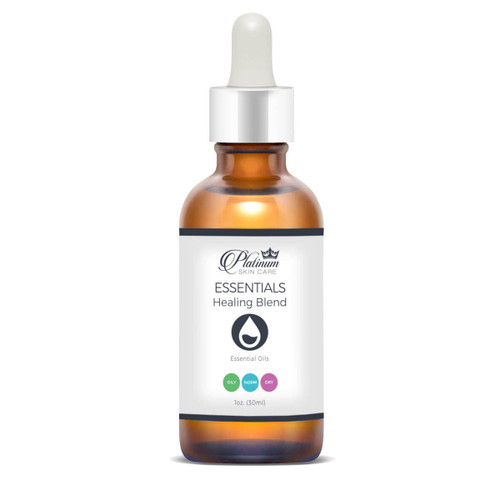About TCA peel 7 - 13 - 20 - 30
CERTIFIED Trichloroacetic (TCA) Acid Peel
Free Acid Value = 7%, 13%, 20% or 30% *Learn about FAV here.
Decades of happy customers.
This is a "cool-action" (7, 13 and 20) TCA peel with an unbuffered pH of 1.3. TCA is the peel that all other peels are compared to! It has been highly used for decades, is simple to use with our direction, and is very predictable. It is preferred over other acids due to its effectiveness and dependability. If you are looking for long-lasting, dramatic changes in the appearance of your skin, TCA is the correct choice for you.
Choose from one of the Four available percentages:
- Level 1 TCA 7% (1.3pH) *Extreme sensitivity. Good for sensitive skin and the eye area.
- Level 2 TCA 13% (1.3pH) *Beginning peelers looking for more flaking than hydroxy acids. **Best choice ethnic.
- Level 3 TCA 20% (1.3pH) *Have been consistently applying 4-5 layers of the 13 and are looking for more. Work up in layers with extreme caution. *Maximum strength for darker tones on body w/melanin inhibitor prep 4 weeks.
- Level 4 TCA 30% (1.3pH) *Warning for diluting, CROSS or body use only. Never a beginner peel. Not for darker skin tones.
![]()
|
DARKER ETHNIC SKIN (Fitzpatrick 4-6) - prepare with a melanin inhibitor such as our Fade Bright or a hydroquinone product for 4 weeks before your peel. Studies have shown that TCA can be safely used in darker skin types. Safe use of TCA requires longer preconditioning of the skin, a milder strength of acid and strategies for dealing with the likeliness of PIH *post inflammatory hyperpigmentation. Preconditioning includes topical agents such as alpha arbutin, retinoids or hydroxy acids that will thin the stratum corneum and minimize the production of melanin. In a deeper peel (20% or several layers of a 13%) PIH can develop when the pink stage of healing starts to fade. Sun blocks, heat avoidance, steroid creams and melanin inhibitors can help to reverse this quickly. After 2 weeks, a non-inflammatory type of acid peel such as Salicylic or mandelic may be used to help treat the pigmentation. |
Dr. Simi has a wonderful video on dark skin and how chemical peels are best used to help treat their hyperpigmentation. We teach the same principles here at Platinum. Please take a look at this if you have time.
PEEL BOOSTERS
Peel boosters are not mandatory in any way to have a successful peel experience. Our TCA peels can be applied as a standalone peel - and we highly recommend this for your first few uses as you learn how the acid works. After you are feeling comfortable, we have found over the years that applying vitamin A to the skin after a peel can help encourage a faster turnover or heavier flaking. This is something many people are looking for. If this is something that you would like to try, then we have two choices for you.
Luminosity - this is our .55% Retinoid Fusion Serum. It can be applied after your TCA peel has finished. It can then be applied one time a day for the next 2-4 days to help encourage more flaking.
Dream Peel tm - this is a standalone vitamin A peel that can also be used as a finishing layer to the TCA or Jessners peels. It is many times stronger than the Luminosity serum. This will be applied only 1x and then not again. It can not be combined with Luminosity.
Who should be using TCA 30%?
The Level 4 is NOT for everyone. We do NOT EVER recommend the direct application of this undiluted solution as a facial peel. This peel in intended to be diluted with the easy to follow instructions included with the package. This level is not created for a first time chemical peel user. The 30% was created for people that:
- Have a desire to use multiple percentages and only want to purchase one product. Dilute to desired percentage (10% - 25%).
- Want to smooth and beautify their bodies or tackle any problem areas. The 30% can be used full-strength for these reasons.
- This is NOT for ethnic skin tones that run a high risk of hyperpigmentation after a strong inflammatory response.
While we often focus on New cell growth, we sometimes forget that the First step in renewal is Destroying the old, broken down cells!
TCA Peel Benefits
A wide variety of chemical peels are available today for use in office and also at home. Each acid can generally treat more than one type of issue, but is commonly used for a particular reason. TCA is special! It is considered "the gold standard" of all peels and is able to treat every skin type, issue and coloration safely. It can be used superficially in very mild percentages (10%-20%), and also for medium depth peels (up to 35% *Office only). It can be used in combination with other acids, such as Jessners or applied alone.
TCA is a highly regarded acid, and many will choose it to enhance and beautify their skin. They may also use it to target specific issues they are dealing with. If you have any of the following, you may find that chemical peels such as TCA could be a valuable tool in your Beauty Arsenal:
- Wrinkles
- Fine Lines
- Skin Tone Irregularities
- Texture Problems
- Scarring and Acne Scars - icepick, rolling
- Age Spots - hyperpigmentation - melasma and freckles. But best addressed by Jessners.
All skin types can benefit from TCA peeling. But, persons that are prone to post-inflammatory hyper-pigmentation, or have a naturally darker skin tone, will need special pre-treatment to avoid any unintended color changes in the skin. These are generally fitzpatrick 4, 5, and 6, but any type could potentially have an issue. It is always best practice to pretreat the skin with a melanin inhibitor when you are preparing for your peel. We suggest to do this for 4 weeks in a row. Then, after your peel is completed, continue so your skin can be at its healthiest looking.
Many products can help with the process of our skin's regeneration. Retinoids, Antioxidants and other such peptides can be supremely helpful. But TCA can really benefit your skin in a way that some other ingredients can not. There is an ongoing process of dermal remodeling that results in "Neocollageneses" or new collagen, after about the six week mark. [read more]
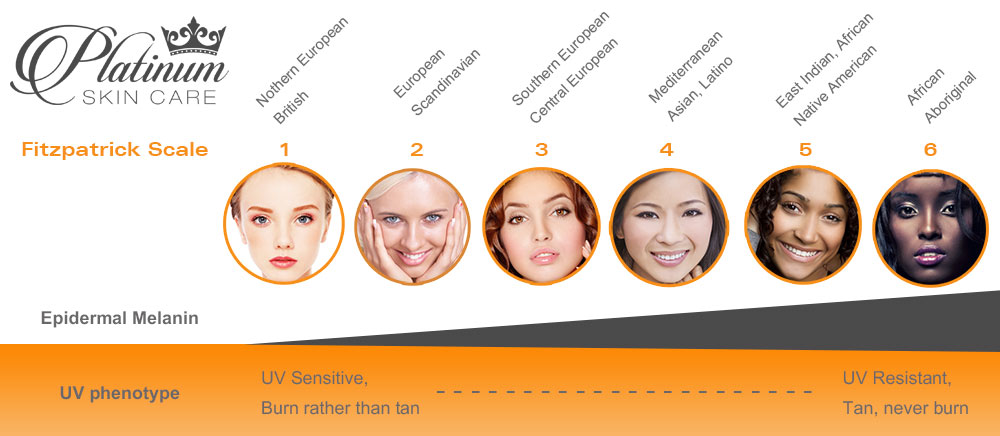
![]() DARKER and ETHNIC SKIN (Fitzpatrick 4-6) - must prepare with a melanin inhibitor such as our Fade Bright for 4 weeks before your peel.
DARKER and ETHNIC SKIN (Fitzpatrick 4-6) - must prepare with a melanin inhibitor such as our Fade Bright for 4 weeks before your peel.
This is available on this page as an "Additional Option". Hydroquinone, Alpha Arbutin or other melanin inhibitors should be used 2x per day for at least 4 weeks to significantly reduce the likelihood that PIH will develop. *It is not guaranteed to eliminate it, just reduce the likeliness of it happening or reduce the rate that it does occur. We highly recommend the use of Fade Bright and offer it as an Option on all our TCA peels.
If you are still unsure of your Fitzpatrick type you can take a Quiz at SkinCancer.org to find out.
SATEFY FIRST - We are offering you an at-home alternative to expensive treatments, but a word of caution. We prefer that you apply more layers of a lesser percentage (such as the 7 or 13% at 2-5 layers) as opposed to a single layer of a high percentage such as the 20% or higher. Another excellent - and even preferred option for helping to lessen hyperpigmentation - is the Jessners peel.
Never move up to the next percentage until you are applying five layers of your current percentage (5 minutes in between layers) and feel that you are ready for more flaking. Exercise caution for the best, most predictable results available.
TCA Peel At Home
TCA peel outcomes are very predictable, and under the proper instruction, milder percentages can safely be performed in the home. They key to an excellent outcome is 1.] adhering to the pre-treatment protocol, 2.] understanding the application method, 3.] providing the proper post care, and following each item precisely. *If you are prone to fever blisters, the acid can cause a breakout. Prescription medications must be used before a TCA peel is applied or the breakouts could cause scarring.
Follow our Pre-Treatment Protocol to get the best results from your TCA peel.
- Begin and End each day by washing with a pH acidic cleanser. *Our Revitalizing Glycolic Cleanser is perfect.
- If you have darker skin, or are dealing with hyperpigmentation/melasma, pretreat 2x per day with a tyrosine inhibitor such as our Fade Bright.
- After cleansing, apply an anti-oxidant such as High Octane Vitamin C serum or another option of your choosing.
- Protect skin with an SPF 50 before going outdoors.
- Each evening gently thin the stratum corneum layer by applying a layer of Vitamin A, such as our Fusion A .15, .25 or .35. Alternatively, you may use the Glycolic & Hyaluronic Multi Acid Serums to perform a similar function.
TCA can be used as a tool in your regimen to help improve the freshness, texture, skin tone, and fine wrinkles. If you have pigmentation troubles, it can also aid in lightening them. It may improve blotches and can sometimes improve dark circles under your eyes. TCA is a natural 2nd step when other acids stop producing benefits.
TCA Peel Instructions
Applying a chemical peel is as straightforward as applying a toner to your skin. With TCA though, we need to control the amount of acid on our applicator. Here at Platinum, we prefer a gauze pad as it will not soak up and waste extra solution. Here is a brief application example. *You will receive our Peel Manual with purchase which has detailed instructions.
How Much Solution Should I use?
A TCA peel gets its strength from being applied in multiple layers. This makes TCA one of the safer acids to apply, as it is very customizable for your needs. A single layer will always be the safest way to start your peel series. Some may use 2 layers.
What is a layer:
A layer is a single application of the acid during a peel treatment. Multiple layers can be applied to progress the acid deeper into the skin if you desire this. ** If this is your first time applying OUR TCA we suggest applying only 1 layer. You can then strengthen the peel with additional layers as you move forward in the process. *30% is for dilution or body use only. It is not intended for layering.
How wet should my gauze be?
A dripping, heavily saturated applicator will lead to unintended results. Instead, do the following: Pour a small amount of solution into a medicine cup. Fold your gauze pad in ½. Dip into solution. Fold pad in ½ and give it a GENTLE squeeze with your fingertips (we still want it wet) or a few shakes. Ready!
- Thoroughly cleanse all areas to be peeled with a deep cleanser.
- Wipe Prep B on all areas to be treated. 90% alcohol may be substituted.
- Apply first layer of TCA peel solution.
- Wait approximately 5 minutes *(the proteins in the skin coagulate, then the acid self-neutralizes).
- Decide if more layers are necessary.
- Apply next layer directly on top of the first. *(It will go through the first layer and coagulate the layer below)
- Wait another 5 minutes.
- More layers are options as you progress in your Peel Series. It is not mandatory for you to do this. Always do what is comfortable for your personal needs.
- Is there frosting apparent on the skin? White hazy. = stop
- Some areas are white and some are not? You may apply another coating of acid to areas that are NOT white.
- Rinse well with cold water.
- Apply Luminosity Method for extra regeneration and peeling. Another option is our Vitamin A Dream Peel as a 1x finish layer.
**Note** Never try to gauge the strength of an acid in a different family to TCA. They are not comparable even if the percentages are the same. If you have more questions relating to acid strengths, please visit our page on everything you wanted to know about chemical peels
Let's Get Technical with TCA
See our Full Direction Manual here
What makes our TCA Peels better? Watch and learn.
TCA peel application. This is a diluted percentage.
If you are interested in applying TCA onto your eye area, see our TCA Eye Peel applied here. We have a wonderful Eye Peel Kit available for you as well with our Matrixyl 35% Synthe'6 Potion and our Luminosity .55%.
TCA peel focusing on the Lip and mouth area. Here we are addressing those pesky Nasal labial folds as well as marionette lines with a targeted application. Using these ingredients can help to beautify and improve the look of the skin for many. We have a great Lip Peel Kit available for you with our Adiopofill Potion and our Luminosity .55%
Here is an alternate, Advanced method of applying a primer of Jessners and then following that up with TCA. *ALWAYS use each acid separately FIRST before layering them in a single session. We suggest at least 1-2 peels of TCA and 1-2 peels of Jessners before you layer.
So, what about men... can they safely apply a TCA peel as well?
Absolutely they can. Most men have a slightly thicker skin than women, so they will be more comfortable during the peel process. We highly recommend that you do NOT shave for 2 days prior to applying a chemical peel. This is because shaving is actually a means of exfoliating, and some of the skin will be removed. This makes your chin and mouth area more prone to a deeper peel than the rest of your face. Embrace your 5:00 shadow and have a safer peel.
Here is a video from Vlogger La Bella Vanity who did a Jessners, TCA and a Dream Peel finish. She had wonderful peeling.
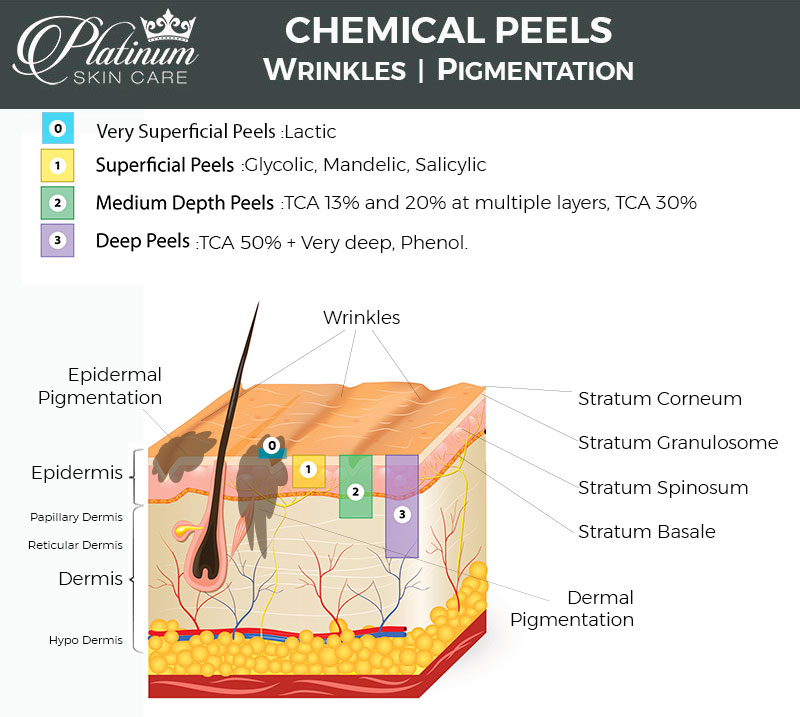
How deep can a TCA peel penetrate in your skin?
The TCA acid can penetrate quite far if a high percentage is applied or multiple layers of a lesser percentage are applied. We always state that it is SAFER to do multiple layers of a lower percentage and will ALWAYS suggest that you do so. This is the Safe process where you build up your layers slowly. The 7 and 13% are the Favorites here at Platinum. We very rarely suggest that you move past the 13. *The body is thicker and is a reason to use a higher percentage generally.
It is considered a medium depth peel when, it can reach down into the epidermis and even a bit into the upper Papillary dermis. This is not something that we recommend here for safety reasons.
Regular hydroxy acids can not penetrate past the Stratum Corneum, so they are considered more of a Superficial peel, very superficial peel, or just an Exfoliation.

TCA Peel Recovery Time
There is no magic system to heal quickly after a TCA peel. It will generally take around 1 week for all of the dead skin to flake off. There is a process your skin will move through.
On the first day of your peel your skin will be tight, smooth and possibly a little bit pink. Keep skin hydrated with emu oil/hyaluronic or another moisturizing product. Within the next 2-3 days your skin will be tighter and could feel dry, *possibly darker on surface areas. Wrinkles/lines may look more prominent as the skin is preparing to come off. Depending on the percentage of acid you applied, and the amount of layers, you will start to see flaking on days 3-4. Flakes will begin on the areas of your face that are in motion such as around the mouth and nose. It will take another 3 days or so for the flaking to stop. Never pick and keep moist. 6-10 days to be completely done.
Debate. Dry or moist skin during healing?
There are conflicting opinions all over as to whether or not you should allow your skin to dry up (thought is that it's better for peeling) or you should hydrate it (fact). Along with dermatologists, we recommend that your skin always be hydrated. If you were to allow your skin to be dry you run the risk of excessive itching or a possible tear as you move your tight skin. Dry skin will give extra tiny flaking. A hydrated face will not only feel more comfortable, but the flakes will come off in larger, more manageable pieces. Hydrating will not slow down or change the effects of a peel. Some flaking you will see and some you will not. Take a moment to look over our TCA peel pictures at the top of the page. They will give you an idea of what the peeling can look like. They are all labeled to show percentages, layers and any extra applications.
What kind of peeling can I expect with a TCA peel?
*If you have used 13% at 5+ layers consistently, then you can potentially move up to 1 layer of the 20%. Be cautious depending on your Fitzpatrick number. Always prep with Fade Bright or Hydroquinone prior to a high % TCA peel for a minimum of 4 weeks to help avoid (or greatly diminish) post-inflammatory hyperpigmentation.

TCA Peel Side Effects
Any chemical peel can give undesired outcomes. That is why preparing the skin prior to a peel is always your best defense. To make sure that you minimize any possible complications, follow protocol.
- PIH - Post inflammatory hyperpigmentation happens when the skin becomes inflamed/damaged/wounded. The epidermis stimulates melanin synthesis and a brown patch will remain after healing. A common example is a dark spot after the inflammation of a pimple is healed. This PIH generally takes several weeks to months to fade.
- By applying a broad spectrum SPF of 40+ daily, a daily antioxidant, Retinol Vitamin A, and a fade gel daily this outcome can greatly be minimized or avoided entirely. Results will always be best when combined with an at home regimen.
- Scarring - Scarring after a chemical peel is extremely rare. If you are among those that have a history of keloid scarring, you would be best to avoid peels in general. Stick with a topical acid serum or Retinol instead.
- Redness - A continued state of redness, called erythema, is not common with a lower strength TCA acid. This is more common with a Phenol peel. If you find yourself dealing with this, the preferred treatment is 1% hydrocortisone for 1-2 weeks to normalize the skin's coloring. Do not apply this for a longer time frame. Do not use a higher percentage of cortisone.
- Infection - The TCA itself will not cause an infection, but if you are Herpes simplex positive, the peel irritation itself could cause an eruption then infection. Use an acyclovir prescription prior to any chemical peel application.
Have You Been Looking For A Vitamin A Peel?
**Well, we have you covered! Advanced and professional peeling methods are our specialty. Choose to add on our Luminosity Method for a spectacular multi-level Vitamin A peel. The dual applications will increase your peeling and enhance your skin's tissue regeneration! Full instructions on how to apply our Luminosity Method are included in every peel booklet. Don't forget to add on our Luminosity cream with your order though, (just select the "Luminosity add on" prior to putting your peel into the cart) to super-charge your next regenerative peel. Anti-Aging to the extreme.
What is Cool-Action?
Since burning, irritation and stingy itching sensations are not qualities people love to deal with, we have added something extra special to this peel. Our Cool-Action is a refreshing additive that will make this THE MOST COMFORTABLE TCA PEEL you have ever had! Our additive will help to minimize the 'burning effect' that many people feel while working with stronger acids. This ingenious action allows for a more comfortable peel for you. Perfectly strong and perfectly comfortable. You will also find this in some of our other more "irritating acid" peel formulas. *The 30% does not contain menthol due to its different dilutant base.

What is a TCA peel?
TCA is one of the most famous, long tested acid peels available. TCA stands for trichloroacetic acid. It is a medium depth peel that has been used with excellent results for over 135 years! That is right. TCA was actually first used as a peel by German dermatologist Paul Gerson Unna back in 1882. He also worked with salicylic acid, resorcinol and phenol. TCA is very commonly used now due to its excellent track record for being very predictable and safe.
TCA can be easily adjusted to any depth needed to address common skin imperfections. For example, someone needing only minor surface improvement, a single application of 10%-15% would be effective. On the other hand, if the problems are deeper in the dermis, a stronger solution or more layers could be applied to reach the issue. We will ALWAYS error on the side of Caution here! Begin slowly and with a lower % of TCA. Work your way up in your layers applied. Take your time. Safety first.
*Caution*
- The number of coats, or
- The volume of solution
will increase the depth of the peel. The percentage does not make the peel move deeper - it is the LAYERS of solution or VOLUME of solution that cause the penetration. We can explain this by teaching you how TCA actually works.
How does TCA work?
TCA's mechanism is different from regular hydroxy acids that just dissolve bonds. Trichloroacetic acid coagulates the proteins in the skin, then "shuts off". So, the more solution that is applied, the deeper the acid will go looking for protein to neutralize itself. If you put on many layers it will keep digging. If you put on a heavy amount of solution (face is too wet), the acid will continue digging until it can neutralize all of the acid. *This is why we are very careful in our Peel Manual to teach you to squeeze out your gauze pad prior to applying acid. We don't want too much acid on at any one time.
Everything is here for you. What makes our TCA peels the best and why they are going to work for you. They are Certified - pH Guaranteed - % Guaranteed - Have Cool Action and are used in Spas and Dermatologist's Offices all over the country costing hundreds of dollars per treatment. They are as comfortable as they can possibly be and are simple to use. We have also included a detailed Direction Booklet that outlines all of our peels, alternative application methods, complete skin prepping and after care recommendations. If you are dealing with acne, pigmentation issues, rough skin texture, wrinkles, scars or just want to look refreshed and amazing, consider adding a chemical peel to your skin care regimen. After a few treatments you will wonder why you ever waited so long to use a Platinum Skin Care TCA Peel! It's time to revisit the top of the page and choose your percentage. While you are up there, take a look at some of our TCA peel pictures!
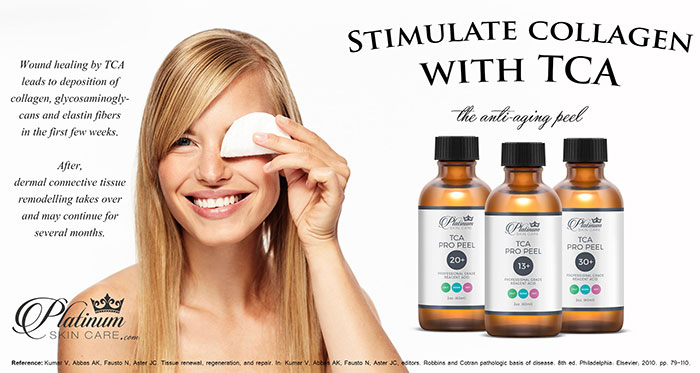
Can TCA really stimulate collagen production in my skin?
Many ingredients can aid in helping our bodies generation collagen ... but, TCA has been around since the 1800's. So, it is a well studied acid and is the "gold standard" of all acids milder than phenol. [1] Wound healing by TCA leads to deposition of collagen, glycosaminoglycans and elastin fibers in the first few weeks. After, dermal connective tissue remodeling takes over which may continue for several months.
Reference [1]: Kumar V, Abbas AK, Fausto N, Aster JC. Tissue renewal, regeneration, and repair. In: Kumar V, Abbas AK, Fausto N, Aster JC, editors. Robbins and Cotran pathologic basis of disease. 8th ed. Philadelphia: Elsevier; 2010. pp. 79–110.
Are you still thirsty for more skin care knowledge?
We are here to help you with TCA peels, skin care regimens and every other product sold on our website. Please pick up the phone and Call us (M-F 1-800-917-3155 9-5 EST) for personal help. You may also send us an email or Chat with us during business hours with the chat box in the lower right corner. Take a few minutes to read over our piles of Testimonials. There are two groups of them on this page and also a side tab (green) where you can scroll through and see the positive reviews of all Platinum Skin Care products. Read on to learn about layers, watch a TCA CROSS Method video, and learn more details about our exceptional TCA peels.
![]()
|
*If you have arrived at this page from the recommendation of our French Blogger, Kay Follow recommendations above and do NOT choose the 30%. TCA 30 is far too strong for a full facial peel. Only purchase this if you are planning on diluting it. Always begin with the 13%. Si vous êtes arrivé à cette page de la recommandation de notre Blogger français, Suivez les recommandations ci-dessus et ne choisissent pas les 30% . TCA 30 est beaucoup trop forte pour un peeling facial complet . Seulement acheter si vous avez décidé de le diluer . Toujours commencer par les 13%. |
Those of you that are not French speaking you can very easily see what Kay has to say by clicking the Closed Caption button (CC) in the video. Then select the settings button (gear) and have it translate into your language of choice. Enjoy her knowledge.

TCA Peel Acne Scars
TCA peel is a great acid to use when targeting problematic scars. The acid can help your skin to break down the scar tissues and stimulate the growth of replacement tissues, you can move things along even faster by incorporating a Copper Peptide into your revision regimen. Go directly to our copper page here.
Take a moment to watch Dr. Moscato perform a TCA CROSS in her office. Notice that she is using a saturated pick and not allowing it to drip on the normal skin. She is very precise with her pressure. Watch her technique and see what you can expect while performing this method at home. *Never, never use a TCA with a higher percentage than the 30% for this method. A higher percentage could burn a hole through your skin.
Now, watch our CEO perform the TCA CROSS method and give you detailed information about which acne scars can be helped with this method as well as how you are going to apply it at home. Prep, application and post care are all described in detail.
Dermatologist Dr. Dray explains how the TCA CROSS Method works in depth.
Ethnic skin needs a bit of extra prep before performing a TCA peel. Watch Instagrammer @detox_body_skin_n_mind perform a TCA CROSS, Face peel and the Eye peel
TCA CROSS for Acne Scarring
The TCA CROSS method is a combination of needling and acid to help break down scar tissue and stimulate the growth of new collagen to fill in depressions. We did not create this method. We are simply explaining how it works for your skin and how to best utilize the knowledge.
We recommend the 20% or 30% for this method. We have found that when trying to improve the look of a scar, adding on a Copper Peptide Remodeling Cream (or serum) can be very helpful. The CROSS method can be done only 1x in a 5 week period. *Full directions included in your Peel Manual.
- Soak wooden pick in peel solution.
- Apply solution to interior of scar with medium pressure.
- Watch for frosting on rim of scar.
- Rinse well with cold water.
- Scab will form.
- Apply copper and emu oil.
Are you unsure if TCA is the right acid for you? Since acids have multiple uses, it can be difficult to make sure you are choosing the best acid for your situation. Don't be unsure. We are here to help you. Give us a call and we can walk through what you have been using and also what you want to accomplish. Once we figure out your exact needs, we can get you into the correct acid and also percentage. If it is after business hours (M-F 9-5 eastern) then you can watch our helpful video (below) to learn more about the acids and their uses. You can also visit our Everything You Want to Know About Chemical Peels Page for detailed and helpful information regarding all of our peels - including TCA.
TCA peel on the body.
If you are thinking about the idea of performing a peel on your body - you are in luck! TCA can definitely be applied to the body as well as the face. There are a few very important things to keep in mind though.
- The skin on the body is thicker. Generally speaking, a higher % of acid will need to be used.
- The process of peeling the body is much slower than a facial peel. Expect a 30 day turnover.
- Prepping the body is just as important as prepping the face. Ethnic Skin must use a melanin inhibitor for 4 weeks.
When we are stating a higher percentage of acid such as TCA 30 should be used, we are generally expressing this for very light skin (Fitzpatrick 1, 2, 3) that is in a healthy, younger individual. As your skin ages, it also gets thinner. A milder percentage will most likely be needed for someone in their upper 50's, 60's and beyond. Better choices would be a 20% and down to a 13%.
As your skin gets darker (Fitzpatrick 4) the percentage of acid should get lower as well. TCA 20% would be much more appropriate for this skin coloring. When skin is in the Fitzpatrick 5 or 6 category, a percentage of 13% is preferable. Any Fitzpatrick coloring above 3, or that has a genetic heritage that is prone to hyperpigmentation or severe marking, should prepare the skin with a melanin inhibitor for at least 3-4 weeks prior to performing any TCA peels. The darker the skin the longer the prep should be.
Watch a comparison of TCA 30 and Glycolic 70 on the hands and arms.
Ingredients
TCA 7, 13 and 20: Purified Water, SD Alcohol 40, Trichloroacetic Acid, Propylene Glycol, Mandelic Acid, Lactic Acid, Sodium Lactate, Glycine, Fructose, Urea, Niacinamide, Inositol, Sodium Benzoate, Benzyl Alcohol, Menthol Crystals
TCA 30: Purified Water, Trichloroacetic acid, Propylene Glycol, Mandelic Acid, Lactic Acid, Sodium Lactate, Glycine, Fructose, Urea, Niacinamide, Inositol, Sodium Benzoate, Benzyl Alcohol. pH 1.2 - 1.4.
Prep B Solution: SD Alcohol 90%, Phenol 1%, Water. (2oz.)
Luminosity Serum: Cyclopentasiloxane, Dimethicone, Dimethiconol, Ethylhexyl Cocoate, Tocopherol, Caprylic / Capric Triglyceride, Retinol, BHT, Dimethylmethoxy Chromanol. pH 5
![]() *California residents: This product This product can expose you to TCA (INCI: trichloroacetic acid). You may still purchase this product by agreeing to our Shipping Policy during the checkout phase.
*California residents: This product This product can expose you to TCA (INCI: trichloroacetic acid). You may still purchase this product by agreeing to our Shipping Policy during the checkout phase.
More Testimonials

Here is a TCA 20% video from DIY Beauty Lab on YouTube. We are going to add some comments here as this is more of a learning moment. NEVER do any other treatments (ie dermaplaning.. microdermabrasion...) prior to a TCA peel. Keep in mind that TCA is self-neutralizing, so a "neutralizer" is not required. Just rinse your face with COLD water to end any burning sensation. No frosting is needed - so please don't feel this is an "end point". We do talk about it so you are not worried if it happens to you.
Always do just a single swipe across the area you are applying this peel to. Don't go back over and over at that point. One swipe and move onto the next area. You will ALWAYS WAIT 5 minutes in between each layer. Never continue layering and layering. Apply... wait.... apply.... wait.... etc...
TCA 13% peel applied by Glama. One layer on entire face and a 2nd spot treated on pigmentation and areas that did not frost. *Latino skin. She did the proper pretreat with Fade Bright for 2 weeks before performing peel.
Here is a wonderful video from Youtube Vlogger Lauries Beauty. She did an at-home TCA peel on the hands with a 20% solution. Generally we do NOT want such wet layers... so please keep that in mind as you watch her demo. A peel that is applied TOO WET... will be much deeper than you anticipated as your skin needs to USE UP every single drop of solution before it self neutralizes.
Always use a gauze so you don't waste too much solution. This hand peel should have been 1 bottle at the most for 3 layers. Always use a gauze pad. Give it a squeeze and apply a thin layer. It should remain wet for maybe 30 seconds. Always start with no more than 2 layers on the body for your first peel and never worry about frosting. If you have ethnic skin please prep with Fade Bright for at least 2-3 weeks prior to applying such a strong peel.
Men... you can peel too! Check out Vlogger Vincent Balducci and his 1 layer TCA 13 peel on day 2
Here is another first time peeler. Enjoy beauty Vlogger Kim Hammon and her TCA 13% application.
Here is Vlogger at LIfe & DIY performing a TCA 20% with great before/during and after photos. She also has a complete review of our TCA peel on her blog here.
Here is Beauty Vlogger Lisa Monique Beauty, her TCA peel and thoughtful comments
Here is another Vlogger Mrskatiecarter and her First Ever Chemical Peel which was our TCA 13% at 2 layers. Watch her.

Robinson, Verified Buyer 10/04/13
GREAT CHOICE. I am AA with medium brown skin that has pigmentation problems. My skin is normally resistant to anything over the counter. But this peel is great! I have only progressed to 3 layers, but that's all I have ever needed. I go from application to completely peeled in about 7 days. The 13% resurfaces my skin nicely with no burning, scarring, or discomfort. Its strong enough to do the job and will keep using this product for quite some time. *Results vary depending on individual needs and product usage. Please see us for personal recommendations.

;) If you are still starved for more information, click on over to our Everything You Ever Wanted To Know About Chemical Peels page ... or, head to the top and make your selections.
While we often focus on new cell growth, we sometimes forget that the first step in renewal is destroying the old, broken-down cellular machinery.
